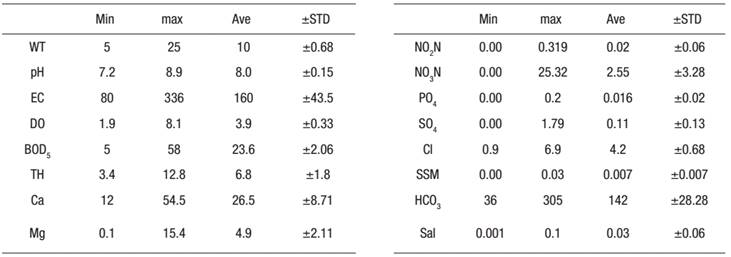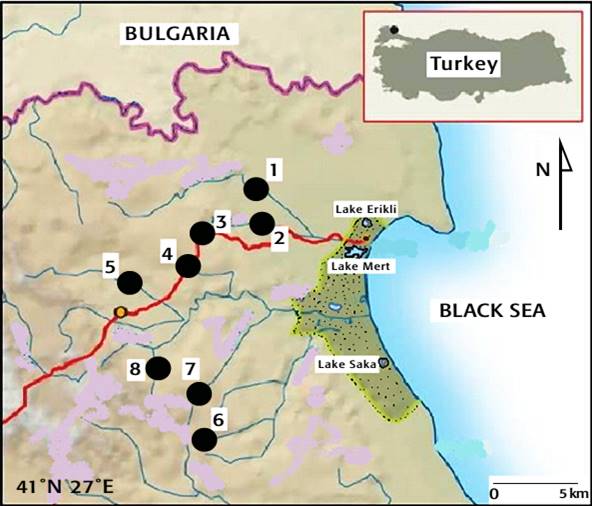Introduction
The "Longoz Forest" is also known as "flooded forest" or "freshwater swamp forest" which is formed by the way the flowing streams recoil towards the sea. In Turkish Thrace, the rivers which flow toward Black Sea from Istranca (Yildiz) Mountain Ranges (Strandzha or Strandja Mountains in Bulgarian) end at the longoz area including some lakes and marshes. Thus, this area are become very important wetlands including a lot of different ecosystems. These longoz areas are uncommon in the world because of their sensitive nature. They consist a lot of physical, chemical, and biological materials such as soil, water, nutrients, foods, and living things. Therefore, the health of a wetland like longos and its biological diversity is directly related to the health of each component of the ecosystem. There are three fundamental living groups in a wetland to determine its efficiency. The group of zoobenthos is one of them and a lot of species belonging to this group indicate the quality of the water because some of them are used as biological indicators (Svensson et al., 1999).
The Igneada Longoz Forests is one of the biggest forest-marsh ecosystems of Turkey. In the region, there are three different longoz areas: Mert, Erikli and Saka Longozes (Fig. 1). These three lakes and their surrounding longoz areas have been announced as "Natural Site Area" by official at 1991 and were announced as "National Park" at 2007. This National Park also provides the services of great value to human society living in the area. Although, there are some limnological studies to determine the physico-chemical properties of the lakes in the longoses and to determine the benthic macrofauna of the area (Kırgiz & Guher, 1994; Guher, 1996; Yesilmen & Kirgiz, 1996; Ozkan, 2006; Camur & Kirgiz, 2000; Camur-Elipek et al., 2012), there are no previous studies on the qualitative and quantitative analyses using both physico-chemical and biological features of water resources feeding this sensitive area. Thus, it was aimed in this study to determine physico-chemical properties of the water resources feeding the area and to support the findings by using some biological data belonging indicator macroinvertebrate groups in aquatic ecosystems.
Materials and Methods
The National Park Igneada Longos Forests is located between 41°051' N and 27°057' S in Kırklareli Province, on the Black Sea coast and to the south of Bulgarian border. This area is fed by a lot of water resources all of them born as groundwater and continues as stream towards the national park and ended at the lakes in the longose groves. The longoz area is covered with water during winter and spring seasons and the streams feed into the area have very low velocity during summer period. The lakes Mert (has 2.2 km2 area and max. 1.5 m depth) and Erikli (has 0.4 km2 area and max. 1.8 m depth) are located in the area and they are fed by some of these streams and provide water for the forests during dry period.
While a total of eight different running waters were sampled at winter, spring, autumn, and summer seasons, two lakes which fed the area during dry seasons were sampled at summer and spring seasons in 2008-2009 for physico-chemical and macroinvertebrate material (Fig. 1). The 1st station (Efendi Stream) has sandy bottom, 2nd station (Igneada Stream) has muddy bottom with detritus, 3rd station (Madara Stream) has pebbles, 4th station (Asker Stream) is surrounded by dense trees, 5th station (Bulanik stream-I) has the bottom with detritus, 6th station (Asmal Stream) has sandy bottom, 7th station (Bulanik Stream-II) has stones and pebbles in its bottom and it is added to Bulanik Stream-I and III after a few km, and 8th station (Bulanik Stream-III) has pebbles in its bottom and it is added to Bulanik stream-I after a few kilometres. The lakes Mert and Erikli are located close to the Black Sea and sometimes are provided a weak connection with sea water.
In this study, water temperature (as ºC using an ordinary thermometer), pH (using a pHmeter), specific conductivity (as µS/cm using a conductivitymeter), and dissolved oxygen (as mg/L using an oxygenmeter) were measured in situ at the field, and other parameters (total hardness as Frº, salinity as ‰, and biological oxygen demand (BOD5), calcium, magnesium, chloride, nitrate nitrogen (NO3-N), nitrite nitrogen (NO2-N), orthophosphate (PO4 -3), sulphate (SO4 -3), free carbon dioxide (CO2), carbonate (CO3), bicarbonate (HCO3), suspended solid material (as mg/L) were measured in the laboratory using standard titration methods (APHA, 1992; Egemen & Sunlu, 1999). Ruttner sampler was used to take water samples material was carried to the laboratory at 5 ºC in black glass bottles including 2 litters. Also, some heavy metal concentrations (Cu, Zn, Fe, Cd) were measured as µg/L in atomic absorption spectrophotometry. The quality level of the water was determined according to official standards of National Water Quality Standards for inland waters of Turkey (SKKY, 2004). Pearson correlation index, Cluster analysis and Correspondence analysis methods were used to determine relationships between the parameters (Krebs, 1999).
Sediment that was taken by hand-grabs or Ekman grab was preserved in plastic bottles containing 70% ethanol. In the laboratory, benthic samples were examined under a stereo binocular microscope and sorted into the lowest possible taxonomic level utilizing the references Edmondson (1959), Gledhill et al. (1976), Brinkhurst & Wetzel (1984), Wetzel et al. (2000), Bouchard (2004), Hacet et al. (2010). Also, EPT index was used to the findings belong to the groups Ephemeroptera Plecoptera and Trichoptera according to WSSI (2000).
Results
While the results belonging the physico-chemical features from seasonal samplings in the running waters were shown at Figure 2 a-o the minimum-maximum values, average and standard deviation (±STD) values were indicated at Table 1. The sampling results belonging physico-chemical analyses obtained from the lakes were given at Table 2 because of different values from running water could not be shown on the same graphics.

Figures 2a-o Some physico-chemical findings of the sampling streams in the National Park Igneada-Longoz.
Table 1 The minimum, maximum, average, and standard deviation results for physico-chemical features of the running waters in Igneada Longoz Forest, Turkey.

Table 2 The average values for physico-chemical features of the lakes Mert and Erikli (Igneada Longoz, Turkey) on sampled dry and wet seasons.

According to Cluster analysis results, the station 1st and 2nd were found to be the most similar to each other with 97.5% similarity and the stations 1st and 4th were found to be the have the most different with 74% similarity (Fig. 3). The lakes Mert and Erikli which have 81% similarity ratio was found different from the sampled streams for the physico-chemical findings. These results were supported by correspondence analysis that indicated the 6th station was found very different from the others while the lakes Erikli and Mert was grouped with together (Fig. 3). In this study, there was not found CO3 and heavy metals (Cu, Zn, Fe, Cd) in all sampling localities during the study period.

Figures 3a-b: a) The dendrograms belonging Cluster analysis b) Correspondence analysis for some physico-chemical findings of the sampling localities.
Altogether, 40 benthic macroinvertebrate taxa were collected from sampling localities and according to the EPT results, the stations 3rd and 8th were found to have the higher quality than the others. But, 1st and 2nd stations, and sampled lakes had been shown very poor quality level for EPT findings.
Discussion
The inland waters have been classified as first class (high quality), second class (less polluted water), third class (polluted water) and fourth class (much polluted water) (SKKY 2004). When the results belonging some physico-chemical features of the stations have been evaluated according to official standards for Turkey, the values of pH, chloride, SO4 and PO4, were found at first quality levels in all sampling stations (SKKY, 2004). It is reported that 12-20 0C ranges for temperature and 6.5-9.0 ranges for pH are suitable values for aquatic life in freshwaters (EPA, 1976). Rain waters from Istranca Mountain Ranges and groundwaters are main sources of the Igneada longoz area. The groundwaters are primary sources for streams especially during dry seasons, and they have naturally low dissolved oxygen values. The cooler groundwater inflows at lower dissolved oxygen concentrations, but rising water temperature of the river improves to hold oxygen of the water. Therefore, low oxygen levels at the upstream of a river is an expected situation. In this study, dissolved oxygen levels were measured at low values and biological oxygen demand values were always high in the running waters because of low oxygen amounts cause to high biological oxygen demands. Dissolved oxygen amount depend on allocton in running waters and diffusion from atmosphere is very important source for oxygen. Water temperature has direct influence on oxygen-holding capacity of water and oxygen solubility in water decreases by warmer temperature. In this study, it was measured the water temperature and dissolved oxygen have to be negative correlation with each other, but these results was not be found at significant statistically. According to Pearson index, dissolved oxygen has been shown negative correlation with conductivity and total hardness (r=-0.70, p<0.05 and r=-0.79, p<0.05, respectively).
Although the total hardness of the running waters was found at very soft water quality level which to have between 3.4 and 12.8 Fr0, it was found at hard quality level at the lakes. Although the salinity values were found at the lowest level in the station 7 with 0.001‰ and the highest in the station 6 with 0.11‰, the salinity was found at high values at sampled lakes with 7.7‰ and 9.5‰. It was reported that unpolluted rivers have 5.8 mg/L chloride values at average, but this value rising 8.3 mg/L in polluted by human activities (Allan, 1995).
When the water quality was evaluated for nutrients, the values of NO3-N, NO2-N, and PO4 were found at first quality levels except 6th station (SKKY, 2004). The high nutrient values at the 6th station may be the location of the station which on the road for animals.
According to Pearson correlation index, while it was determined positive correlation between conductivity and chloride (r=+0.76), total hardness (r=+0.91), calcium (r= +0.75), magnesium (r=+0.87), it was found negative correlation between dissolved oxygen and conductivity (r=-0.70), total hardness (r=-0.79) for p<0.05. Also, it was found positive correlations between the values of NO2-N and NO3-N (r=+0.97, p<0.05). The correlation between the other parameters is not found significant statistically.
Macroinvertebrates are the most commonly group used in the assessment of water quality (Dugel & Kazanci, 2004; Menetrey et al., 2008; Girgin, 2010). Also, the EPT index is the total number of distinct taxa within the groups Ephemeroptera, Plecoptera, Trichoptera and the number is compared with EPT rating chart (WSSI, 2000). This index ranges 0 and >27 and it has correspondence with water quality (>27: excellent; 21-27: good; 14-20: good-fair; 7-13: fair; 0-6: poor) (WSSI 2000). The sampling localities were found between poor and fair quality level for the EPT findings (Table 3).
Table 3 Benthic macroinvertebrates and EPT index results determining from sampling localities on National Park Igneada Longoz, Turkey.

The basic conditions for the continuity of this special ecosystem are to have plenty of water. The organic material that is bringing by streams enriches the area in terms of minerals. As a result, it was observed that physico-chemical properties of the waters resources that are feeding Igneada longos area have first quality level at generally. Therefore, the water resources present the best quality water to this sensitive nature but it needs to protect by laws and periodic observations of water resources in the area because of the intense usage of the area as national park for visitors. Also, to protect the nature of the area, it should not be done any application for changing the hydrology of stream waters fed into the longoses.











 nueva página del texto (beta)
nueva página del texto (beta)



